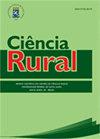Development of an intervertebral disc prosthesis prototype for the canine cervical spine
IF 0.9
4区 农林科学
Q3 AGRONOMY
引用次数: 0
Abstract
ABSTRACT: Cervical arthroplasty with disc prosthesis has been proposed as a treatment option for dogs with Cervical Spondylomyelopathy. The present study developed a novel vertebral disc prosthesis for dogs. Sixteen Functional Spinal Units (C5-C6) were collected from dog cadavers with body weights ranging between 25 and 35 kg, and their vertebral measurements were used to design a prosthetic disc. The sizing of the prosthesis was performed based on the averages of the measurements of width, height, and length of the vertebral bodies from C5-C6 of all specimens. The prosthesis was developed using the Rhinoceros 3D® and SolidWorks® programs, and 3D prototyping was carried out to define the best design. The developed prosthesis consisted of two independent parts that are fixed to the cranial and caudal vertebral bodies, in the intervertebral space, and fitted together by metal-to-metal surfaces capable of moving in the lateral, ventral, and dorsal directions. Each part of the prosthesis is angled in two portions: vertically, in the intervertebral space, and horizontally, in contact with the ventral surface of the vertebral bodies, both of which are fixed by means of monocortical locking screws. The design of the developed prototype allowed a good fit in the intervertebral space between C4-C5, C5-C6, and C6-C7.犬颈椎椎间盘假体原型的研制
摘要:椎间盘假体颈椎关节置换术已被提出作为治疗犬颈椎病的一种选择。本研究开发了一种新型的狗椎间盘假体。从体重在25至35 kg之间的狗尸体中收集了16个功能脊柱单元(C5-C6),并使用它们的椎体测量值来设计假椎间盘。假体的尺寸是根据所有标本C5-C6椎体的宽度、高度和长度的平均值来确定的。使用Rhinoceros 3D®和SolidWorks®程序开发假体,并进行3D原型设计以确定最佳设计。所开发的假体由两个独立的部分组成,分别固定在颅椎体和尾椎体的椎间隙上,并通过能够在外侧、腹侧和背侧方向移动的金属对金属表面连接在一起。假体的每个部分都有两部分的角度:垂直方向,在椎间隙中,水平方向,与椎体的腹面接触,两者都通过单皮质锁定螺钉固定。所开发的原型设计允许C4-C5、C5-C6和C6-C7之间的椎间隙良好配合。
本文章由计算机程序翻译,如有差异,请以英文原文为准。
求助全文
约1分钟内获得全文
求助全文
来源期刊

Ciencia Rural
AGRONOMY-
CiteScore
1.70
自引率
0.00%
发文量
233
审稿时长
2-4 weeks
期刊介绍:
The purpose of Ciência Rural is to publish the results of original research, note and reviews which contribute significantly to knowledge in Agricultural Sciences. Preference will be given to original articles that develop news concepts or experimental approaches and are not merely repositories of scientific data. The decison of acceptance for publication lies with the Editors and is based on the recommendations of Editorial Comission, Area Committee and/ or ad hoc reviewers. The editors and reviewers are external to the institution.
 求助内容:
求助内容: 应助结果提醒方式:
应助结果提醒方式:


